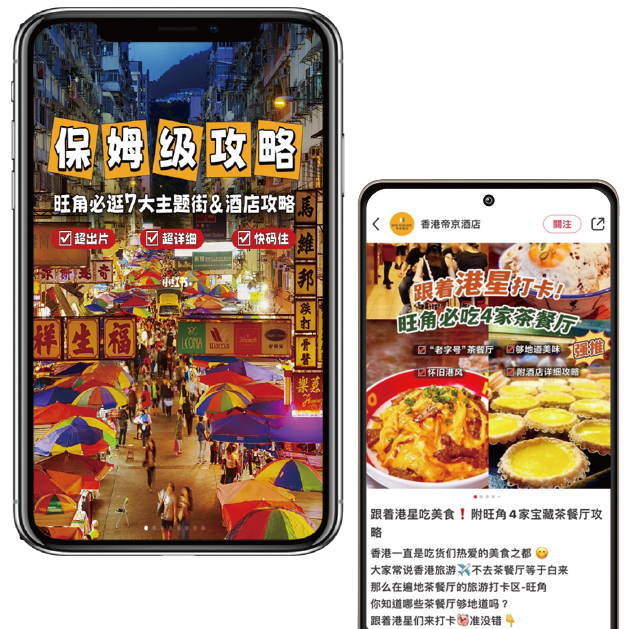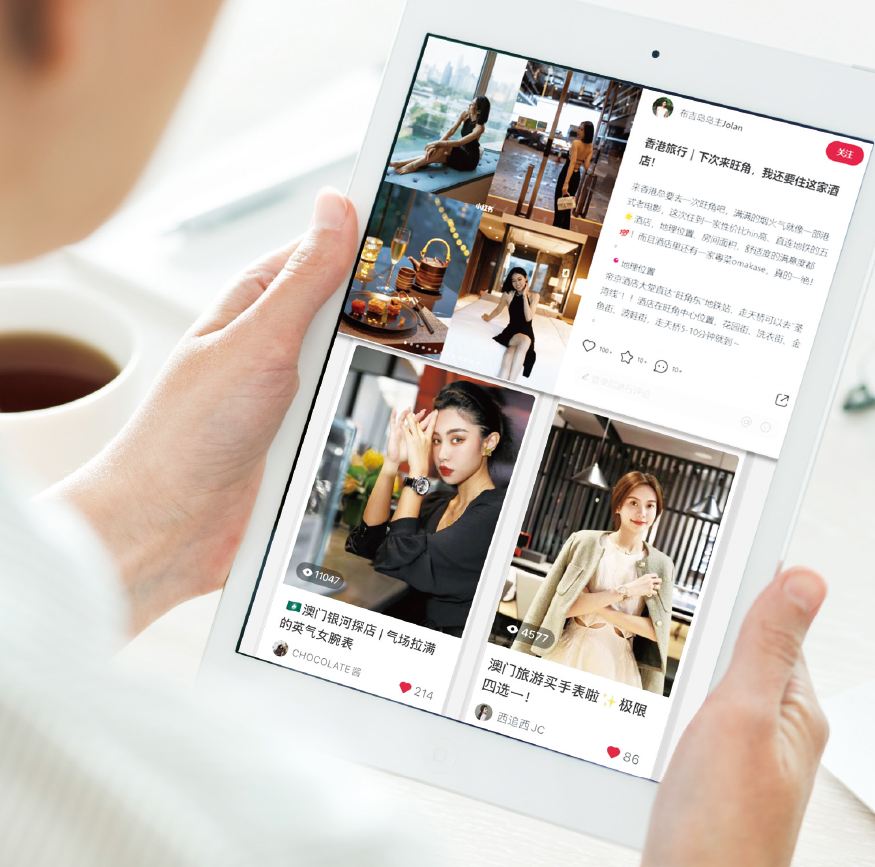Hong Kong tourism innovated by Xiaohongshu
As the COVIDs pandemic is fading, Hong Kong has welcomed around 13 million tourists in the first of this year. Around 80% are visiting from the Mainland and many are pursuing in-depth traveling. In particular, the new generation of visitors is inspired by the “walkthroughs” posted on Xiaohongshu and similar social media platforms. The local tourism industry is prepared to embrace this new trend.
Dane Cheng

Promote Post-COVID In-depth Cultural Tourism
The number of inbound travelers has reached 13 million during the first six months of 2023. According to the forecast of the Hong Kong Tourism Board (HKTB), the annual visitations might reach 30 million. Dane Cheng, Executive Director of HKTB, commented that “cultural tourism” of the city has successfully attracted interest in “in-depth traveling”, especially younger tourists.
HK’s culture & nature attract tourists
 The latest hotspots, including the West Kowloon Cultural District, iconic movie locations, and concerts, all reflect the unique charm of Hong Kong. Cheng believes more tourists will be drawn to explore the East-meets-West art and culture of the city.
The latest hotspots, including the West Kowloon Cultural District, iconic movie locations, and concerts, all reflect the unique charm of Hong Kong. Cheng believes more tourists will be drawn to explore the East-meets-West art and culture of the city.A HKTB survey on tourists found that they are equally enthusiastic about the rich biodiversity and natural appeals of Hong Kong. As these diverse attractions can all be reached within a short ride, Cheng is confident that such enriching travel experience will remain a distinctive strength for Hong Kong’s tourism.
Tourists share travel experience on social media
The unrivaled features of Hong Kong’s tourism must be publicized through the right promotion channels. The rising popularity of social media in recent years, especially China’s Xiaohongshu (also known as the Little Red Book), is characterized by countless sharing on how to experience and connect with Hong Kong by young Mainland tourists.
Cheng pointed out that tourists tend to uncover recommendations online to customize their own authentic yet lesser-known itineraries with popular check-in spots. For example, they would take photos with interesting road signs (an example is MacDonnell Road, the Chinese name of which is exactly the same as that of the fast-food chain). They also enjoy “treasure hunting” for vintage electronics along Apliu Street or visiting Tai Kwun to learn more about the history of Hong Kong. “The creative social media posts offer a wealth of first-hand traveling experience, which has now turn into a new trend.”
Multiple tactics to target different segments
In response, HKTB has been communicating Hong Kong’s allure as a destination through social media platforms such as Xiaohongshu. Cheng shared that HKTB began creating word-of-mouth for Hong Kong’s tourism since the end of last year. The industry, the media, and the Mainland influencers were invited to personally visit Hong Kong.
 Cheng added that as influencers have their own followings, HKTB tailored various thematic itineraries for them. “Capitalizing on their online presence, and by posting the information as ‘walkthroughs’, we hope to attract more mainland tourists to Hong Kong.” At the same time, HKTB also worked with WeChat and invited their content creators to help with advertising and promotion.
Cheng added that as influencers have their own followings, HKTB tailored various thematic itineraries for them. “Capitalizing on their online presence, and by posting the information as ‘walkthroughs’, we hope to attract more mainland tourists to Hong Kong.” At the same time, HKTB also worked with WeChat and invited their content creators to help with advertising and promotion.Cheng emphasized that the local tourism industry is gradually stepping up their efforts, and HKTB will ride on its global network and platforms to support and assist in promoting attractive world-class events, such as the Hong Kong Marathon, the Hong Kong Sevens, etc. He is confident that the collaboration among different stakeholders will enable Hong Kong to further fortify its status as destination of choice for tourists around the globe.
Daniel Chan

Market Hong Kong As A Tourist Destination with A Xiaohongshu Business Card
Now in its tenth year, Xiaohongshu is supported by 300 million active users with continuous growth projected for the future. It is a highly influential social platform.
Daniel Chan, the Chamber’s Committee Member and CEO of AsiaPac Net Media Ltd, has witnessed rapid changes over the years as a player in the Mainland social media market. “Xiaohongshu contents have evolved dynamically to cover diverse scenarios in life. Today, it is a daily life encyclopedia for a wide audience of all age groups, making increasingly vital bearing on people’s lifestyle and consumption decisions.” Most users think Xiaohongshu contents are more authentic and reliable than other social media. “As opposed to users of other platforms who are inclined to buy a product after reading related contents for at least six times, Xiaohongshu users develop consumption desires after coming across related contents just three times.”
Ride the wave of heritage city tours
 In the past, visitors came to Hong Kong to shop for luxury goods. Chan says tourist consumption preferences have changed in recent years. There has been a new interest in experiential discovery tours that present the city’s culture and heritage, such as historical buildings, book shops with a strong sense of design or style, cafés or even MTR stations. “For example, MacDonnell Road, Fife Street and other street signs are hot with tourists.”
In the past, visitors came to Hong Kong to shop for luxury goods. Chan says tourist consumption preferences have changed in recent years. There has been a new interest in experiential discovery tours that present the city’s culture and heritage, such as historical buildings, book shops with a strong sense of design or style, cafés or even MTR stations. “For example, MacDonnell Road, Fife Street and other street signs are hot with tourists.”He points out that most young Mainland visitors search the internet for strategies and walkthroughs before coming to Hong Kong. Dummies’ guide and special sharing guides are favorites. “For instance, young people like to visit shooting locations of Hong Kong TV drama series and movies. Many make their own itineraries for Hong Kong TV drama one-day tours or Hong Kong movie one-day tours.”
Cater to visitors’ taste and market Hong Kong by word-of-mouth
More than 170,000 brands have established a presence on Xiaohongshu, including a growing number of Hong Kong names with an eye towards Mainland marketing. Chan shared a case where his team drew up a Xiaohongshu marketing strategy for a five-star hotel in Mongkok. Actions include setting up a brand account on Xiaohongshu, “seeding” (recommending hit products to stoke purchase desire) and arranging promotional site visits by KOLs. Topics related to holidaying in Hong Kong were also posted. Coupled with eye-catching ad covers, tag lines and hashtags, these features worked well to boost the number of searches and overall exposure.
“In just two months, these posts clocked more than 110,000 views and the number of fans hiked 12 times in one month.” Chan believes that with the right platform, brands can plant contents in target users’ mind progressively to boost sales by word-of-mouth and turn social media traffic into offline consumption over time.
“Seeding” and KOL strategy main thrust of marketing campaign
Chan has seen the Mainland social media market’s transition from being text-based to video-based. He believes what KOLs and amateurs share on social media are genuine personal experiences. He suggests brands to choose the right KOLs who suit their corporate image as spokespersons based on their background, fan group and platform interaction performance. They can also use big data to identify Xiaohongshu trending topics and create viral posts and hot-sellers with hot search keywords. “The trick is to create customized contents for different customer groups and strike the right chord with down-to-earth buzzwords.”
Chan stresses that social media platforms are shopwindows that draw traffic to merchant pages. A brand account on Xiaohongshu is like a business card. He hopes companies engaged in local tourism can turn this channel to their advantage and help raise awareness and popularity of Hong Kong as a tourist destination.




